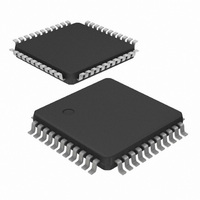P87C51RC2BBD,157 NXP Semiconductors, P87C51RC2BBD,157 Datasheet - Page 39

P87C51RC2BBD,157
Manufacturer Part Number
P87C51RC2BBD,157
Description
IC 80C51 MCU 512 RAM 44LQFP
Manufacturer
NXP Semiconductors
Series
87Cr
Datasheet
1.P87C51RC2FA512.pdf
(67 pages)
Specifications of P87C51RC2BBD,157
Program Memory Type
OTP
Program Memory Size
32KB (32K x 8)
Package / Case
44-LQFP
Core Processor
8051
Core Size
8-Bit
Speed
33MHz
Connectivity
EBI/EMI, UART/USART
Peripherals
POR, PWM, WDT
Number Of I /o
32
Ram Size
512 x 8
Voltage - Supply (vcc/vdd)
2.7 V ~ 5.5 V
Oscillator Type
Internal
Operating Temperature
0°C ~ 70°C
Processor Series
P87C51
Core
80C51
Data Bus Width
8 bit
Data Ram Size
512 B
Interface Type
UART
Maximum Clock Frequency
16 MHz
Number Of Programmable I/os
32
Number Of Timers
4
Operating Supply Voltage
2.7 V to 5.5 V
Maximum Operating Temperature
+ 70 C
Mounting Style
SMD/SMT
3rd Party Development Tools
PK51, CA51, A51, ULINK2
Minimum Operating Temperature
0 C
Package
44LQFP
Device Core
80C51
Family Name
87C
Maximum Speed
33 MHz
Cpu Family
87C
Device Core Size
8b
Frequency (max)
33MHz
Total Internal Ram Size
512Byte
# I/os (max)
32
Number Of Timers - General Purpose
3
Operating Supply Voltage (typ)
3.3/5V
Operating Supply Voltage (max)
5.5V
Operating Supply Voltage (min)
2.7V
Instruction Set Architecture
CISC
Operating Temp Range
0C to 70C
Operating Temperature Classification
Commercial
Mounting
Surface Mount
Pin Count
44
Package Type
LQFP
Lead Free Status / RoHS Status
Lead free / RoHS Compliant
For Use With
OM10064 - EMULATOR 80C51 PDS51-MK2
Eeprom Size
-
Data Converters
-
Lead Free Status / Rohs Status
Compliant
Other names
935272152157
P87C51RC2BBD
P87C51RC2BBD
P87C51RC2BBD
P87C51RC2BBD
Available stocks
Company
Part Number
Manufacturer
Quantity
Price
Company:
Part Number:
P87C51RC2BBD,157
Manufacturer:
NXP Semiconductors
Quantity:
10 000
Philips Semiconductors
PCA Watchdog Timer
An on-board watchdog timer is available with the PCA to improve the
reliability of the system without increasing chip count. Watchdog
timers are useful for systems that are susceptible to noise, power
glitches, or electrostatic discharge. Module 4 is the only PCA module
that can be programmed as a watchdog. However, this module can
still be used for other modes if the watchdog is not needed.
Figure 30 shows a diagram of how the watchdog works. The user
pre-loads a 16-bit value in the compare registers. Just like the other
compare modes, this 16-bit value is compared to the PCA timer
value. If a match is allowed to occur, an internal reset will be
generated. This will not cause the RST pin to be driven high.
In order to hold off the reset, the user has three options:
1. periodically change the compare value so it will never match the
2. periodically change the PCA timer value so it will never match
3. disable the watchdog by clearing the WDTE bit before a match
2003 Jan 24
80C51 8-bit microcontroller family
with 512B/1KB RAM, low voltage (2.7 to 5.5 V), low power, high
speed (30/33 MHz)
PCA timer,
the compare values, or
occurs and then re-enable it.
WRITE TO
CCAP4H
1
WRITE TO
CCAP4L
0
RESET
ENABLE
Figure 30. PCA Watchdog Timer mode (Module 4 only)
8KB/16KB/32KB/64KB OTP
CCAP4H
16–BIT COMPARATOR
CH
PCA TIMER/COUNTER
CIDL
––
ECOMn
WDTE
CCAP4L
CL
CAPPn
39
––
0
MODULE 4
timer is never disabled as in option #3. If the program counter ever
MATCH
The first two options are more reliable because the watchdog
goes astray, a match will eventually occur and cause an internal
reset. The second option is also not recommended if other PCA
modules are being used. Remember, the PCA timer is the time
base for all modules; changing the time base for other modules
would not be a good idea. Thus, in most applications the first
solution is the best option.
Figure 31 shows the code for initializing the watchdog timer.
Module 4 can be configured in either compare mode, and the WDTE
bit in CMOD must also be set. The user’s software then must
periodically change (CCAP4H,CCAP4L) to keep a match from
occurring with the PCA timer (CH,CL). This code is given in the
WATCHDOG routine in Figure 31.
This routine should not be part of an interrupt service routine,
because if the program counter goes astray and gets stuck in an
infinite loop, interrupts will still be serviced and the watchdog will
keep getting reset. Thus, the purpose of the watchdog would be
defeated. Instead, call this subroutine from the main program within
2
16
CAPNn
count of the PCA timer.
––
0
MATn
––
1
P87C51RA2/RB2/RC2/RD2
TOGn
CPS1
X
CPS0
PWMn
0
ECCFn
ECF
X
CMOD
(D9H)
RESET
CCAPM4
(DEH)
SU01612
Product data
















